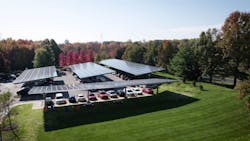In 2020, Siemens launched a living lab at its US technology headquarters in Princeton, N.J. The goal was to reduce the facility’s carbon emissions and to showcase how microgrids can be used by comparable facilities.
Last week, the company, which is one of the most active in the microgrid space, expanded its demonstration capabilities with the launch of an interactive virtual environment. Now, the public, customers and partners have the ability to tour the microgrid system from anywhere in the world.
A virtual look at a real-life microgrid
The virtual environment offers two guided tours.
The first provides an automated, high level look at the entire microgrid system in place at Siemens’ technology research and development center. The second provides a more in-depth look at each of the major components of the microgrid. Users can get the specifications of the microgrid’s major components, including the controller, the photovoltaic canopy system, electric vehicle charging stations, battery storage systems and switches.
Additionally, users may explore the space at their own pace by selecting the specific microgrid component they want to learn about, rather than taking the guided tour. Most sections of the self-guided virtual environment allow the visitor to click on a specific component to get a closer look and learn more.
The virtual environment also features a demonstration of the microgrid dashboard, which shows how the microgrid manages and controls renewable and traditional energy for the research and development campus in real time.
Carbon neutral by 2030
The microgrid is enabling the Princeton facility to become self-sufficient and reach its goal of carbon neutrality by 2030, according to Siemens, which describes it as a true living lab. Siemens researchers and their partners are studying the system as a whole, as well as each individual component, to improve microgrid designs that can serve a variety of users including universities, office parks and industrial parks.
When the living lab was launched three years ago, Dave Hopping, president and CEO of Siemens Smart Infrastructure North America, said one of the company’s goals was to “demystify the difficulties around installing and operating a microgrid to provide a clear path towards clean energy and carbon neutrality.”
The new virtual environment is another step in achieving that goal, a way to make the technology more accessible to the public, customers and microgrid partners.
Interested in microgrids? Join us for Microgrid 2023: Lights On!, the annual Microgrid Knowledge conference. Registration is now open for the May 16-17 event in Anaheim, California.








